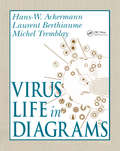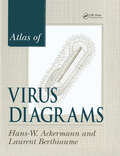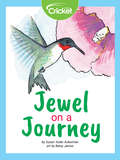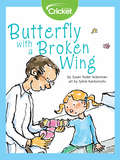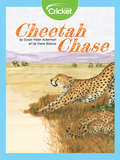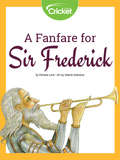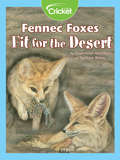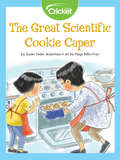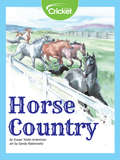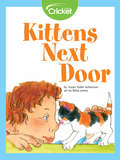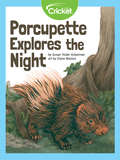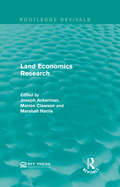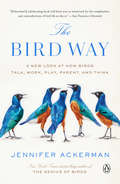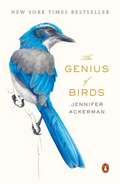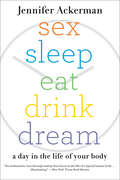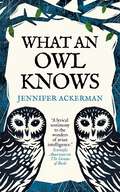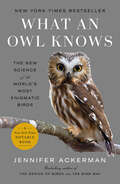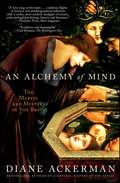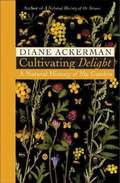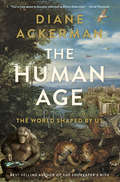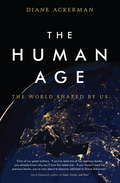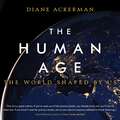- Table View
- List View
Sergei Vinogradskii and the Cycle of Life
by Lloyd AckertThis is one of those biographies that provide a window onto the broader understanding of science in its social and cultural context. Using Sergei Nikolaevich Vinogradskii's career and scientific research trajectory as a point of entry, this book illustrates the manner in which microbiologists, chemists, botanists, and plant physiologists inscribed the concept of a "cycle of life" into their investigations. Their research transformed a longstanding notion into the fundamental approaches and concepts that underlay the new ecological disciplines that emerged in the 1920s. The book presents a reconstruction of significant episodes of Vinogradskii's laboratory practices and the role of theory in their development. It paints the broader picture of the history of ecology, microbiology and soil science and how these are uniquely united: through the concept of the cycle of life.
Virus Life in Diagrams
by Hans-Wolfgang Ackermann Laurent Berthiaume Michel TremblayThis atlas presents 233 virus diagrams selected for their scientific content, clarity, originality, and historic, didactic, and aesthetic value. Virus Life in Diagrams assembles the many diagrams of viral life cycles, particle assembly, and strategies of nucleic acid replication that are scattered throughout the literature. The diagrams cover vertebrate, invertebrate, plant, bacterial, fungal, and protozoal viruses, viroids, and prions. They offer a dynamic illustration of the time course of viral life cycles not available in photographs. They also offer speculative elements that project the possible results of future research, as well as historical documentation that shows the development of virology. This valuable reference book for virologists, microbiologists, molecular biologists, geneticists, and students in these areas is the first atlas to compile illustrations of viral morphogenesis in one complete source.
Atlas of Virus Diagrams
by Hans-Wolfgang Ackermann Laurent BerthiaumeAuthored by electron microscopists and leading members of the International Committee on Taxonomy of Viruses (ICTV), the Atlas of Virus Diagrams includes chapters on virus classification. The diagrams, selected for content and historic and aesthetic value, illustrate vertebrate, invertebrate, and plant bacterial viruses taken from English, French, and German language virological literature. The book presents this information in three sections: Overviews, including vertebrate and plant virusesViruses with cubic and helical symmetryViruses with binary symmetry (tailed bacteriophages).
Jewel on a Journey
by Susan Yoder Ackerman Betsy JamesTrey and Susannah hear a loud thump and learn that the fallen tiny bird laying on their deck is a Hummingbird! Miss Nora, their neighbor, cares for birds and may be able to help them save the bird. Discover what Miss Nora does to help the Hummingbird. Will the injured bird fly again?
Butterfly with a Broken Wing
by Susan Yoder AckermanWhen Ella tries to fly like a butterfly, she ends up with an injury to her arm.
Cheetah Chase
by Susan Yoder AckermanDuma the cheetah is showing her cubs how to hunt in the Africa grasslands. Learn all about cheetahs and the speedy qualities they have that allow them to be effective hunters. WIll Duma be able to catch her family’s next meal?
A Fanfare for Sir Frederick
by Susan Yoder AckermanAgnes is learning how to play the trumpet! Every time she tries to practice, though, an old knight bursts in because he thinks her trumpet sounds like a dragon. Through these interruptions, she learns the knight is responsible for stopping attacks on their kingdom. How can she help this bored hero?
Fennec Foxes Fit for the Desert
by Susan Yoder AckermanHere is the story of Zerda, a little fennec fox from the Sahara Desert. She lives with her parents and brothers in a den.
The Great Scientific Cookie Caper
by Susan Yoder AckermanLucas and Samia decide to use the scientific method when helping Grandma bake cookies. They change ingredients one by one to result in a unique cookie each time. Samia tries adding more flour for softer cookies, and Lucas tries adding melted butter with dissolved sugar for crispier cookies.
Horse Country
by Susan Yoder AckermanKyle is afraid of horses, so the last thing he wants to do is go horseback riding with his Aunt Maggie. As he interacts with them and learns more about them, however, he begins to appreciate them. He learns that horses are not just pets—they can also be friends!
Kittens Next Door
by Susan Yoder AckermanTrixie the cat next door had kittens! John's friend Everrett teaches him all about newborn kittens in the first six weeks of life.
Porcupette Explores the Night
by Susan Yoder AckermanDid you know a baby porcupine is called a porcupette? Learn about porcupines as you follow Porcupette through the forest one night as she looks for a snack!
The Lonely Phone Booth
by Peter AckermanA sad, forgotten, New York City phone booth becomes a hero in this story of community and caring for others. The Phone Booth on the corner of West End Avenue and 100th Street was one of the last remaining phone booths in New York City. Everyone used it―from ballerinas and birthday clowns, to cellists and even secret agents. Kept clean and polished, the Phone Booth was proud and happy until, the day a businessman strode by and shouted into a shiny silver object, &“I&’ll be there in ten minutes.&” Soon everyone was talking into these shiny silver things, and the Phone Booth stood alone and empty, unused and dejected. How the Phone Booth saved the day and united the neighborhood to rally around its revival is the heart of this touching story. The Lonely Phone Booth has a lot to say about the enduring power of the faithful things in our lives. For children, it&’s a wonderful way to talk about their own communities.&“A story celebrating the fabric of a neighborhood.&” ―New York Times Book Review&“Evoking the same kind of New York charm as favorites like The Little Red Lighthouse and the Great Gray Bridge and The House on East 88th Street, screenwriter Ackerman celebrates a humble phone booth (still standing at 100th Street and West End Avenue) that saves the Upper West Side—and vice versa . . . . Cultural history of the best sort.&” —Publishers Weekly&“The art not only tells a splendid story in and of itself, but it also celebrates the colorful and diverse people who live in New York City.&” —Through the Looking Glass Children&’s Book Review
Land Economics Research: Papers Presented At A Symposium Held At Lincoln, Nebraska, June 16-23, 1961 (Routledge Revivals)
by Joseph Ackerman Marion Clawson Marshall HarrisOriginally published in 1962, Land Economics Research brings together papers presented at a symposium in Nebraska in 1961 which deal with ideas, theories and suggestions in land economics to encourage problem-solving in American land issues. This report draws on all types of land, all situations and all economics problems related to land issues. This title will be of interest to students of Environmental Studies and Economics as well as professionals.
The Bird Way: A New Look at How Birds Talk, Work, Play, Parent, and Think
by Jennifer AckermanFrom the New York Times bestselling author of The Genius of Birds, a radical investigation into the bird way of being, and the recent scientific research that is dramatically shifting our understanding of birds -- how they live and how they think.&“There is the mammal way and there is the bird way.&” But the bird way is much more than a unique pattern of brain wiring, and lately, scientists have taken a new look at bird behaviors they have, for years, dismissed as anomalies or mysteries –– What they are finding is upending the traditional view of how birds conduct their lives, how they communicate, forage, court, breed, survive. They are also revealing the remarkable intelligence underlying these activities, abilities we once considered uniquely our own: deception, manipulation, cheating, kidnapping, infanticide, but also ingenious communication between species, cooperation, collaboration, altruism, culture, and play. Some of these extraordinary behaviors are biological conundrums that seem to push the edges of, well, birdness: a mother bird that kills her own infant sons, and another that selflessly tends to the young of other birds as if they were her own; a bird that collaborates in an extraordinary way with one species—ours—but parasitizes another in gruesome fashion; birds that give gifts and birds that steal; birds that dance or drum, that paint their creations or paint themselves; birds that build walls of sound to keep out intruders and birds that summon playmates with a special call—and may hold the secret to our own penchant for playfulness and the evolution of laughter. Drawing on personal observations, the latest science, and her bird-related travel around the world, from the tropical rainforests of eastern Australia and the remote woodlands of northern Japan, to the rolling hills of lower Austria and the islands of Alaska&’s Kachemak Bay, Jennifer Ackerman shows there is clearly no single bird way of being. In every respect, in plumage, form, song, flight, lifestyle, niche, and behavior, birds vary. It is what we love about them. As E.O Wilson once said, when you have seen one bird, you have not seen them all.
The Genius of Birds
by Jennifer Ackerman<P>Birds are astonishingly intelligent creatures. In fact, according to revolutionary new research, some birds rival primates and even humans in their remarkable forms of intelligence. Like humans, many birds have enormous brains relative to their size. Although small, bird brains are packed with neurons that allow them to punch well above their weight. <P> In The Genius of Birds, acclaimed author Jennifer Ackerman explores the newly discovered brilliance of birds and how it came about. As she travels around the world to the most cutting-edge frontiers of research-- the distant laboratories of Barbados and New Caledonia, the great tit communities of the United Kingdom and the bowerbird habitats of Australia, the ravaged mid-Atlantic coast after Hurricane Sandy and the warming mountains of central Virginia and the western states--Ackerman not only tells the story of the recently uncovered genius of birds but also delves deeply into the latest findings about the bird brain itself that are revolutionizing our view of what it means to be intelligent. <P>Consider, as Ackerman does, the Clark's nutcracker, a bird that can hide as many as 30,000 seeds over dozens of square miles and remember where it put them several months later; the mockingbirds and thrashers, species that can store 200 to 2,000 different songs in a brain a thousand times smaller than ours; the well-known pigeon, which knows where it's going, even thousands of miles from familiar territory; and the New Caledonian crow, an impressive bird that makes its own tools. <P>But beyond highlighting how birds use their unique genius in technical ways, Ackerman points out the impressive social smarts of birds. They deceive and manipulate. They eavesdrop. They display a strong sense of fairness. They give gifts. They play keep-away and tug-of-war. They tease. They share. They cultivate social networks. They vie for status. They kiss to console one another. They teach their young. They blackmail their parents. They alert one another to danger. They summon witnesses to the death of a peer. They may even grieve. <P>This elegant scientific investigation and travelogue weaves personal anecdotes with fascinating science. Ackerman delivers an extraordinary story that will both give readers a new appreciation for the exceptional talents of birds and let them discover what birds can reveal about our changing world. Incredibly informative and beautifully written, The Genius of Birds richly celebrates the triumphs of these surprising and fiercely intelligent creatures. <P><b>A New York Times Bestseller</b>
Sex Sleep Eat Drink Dream: A Day in the Life of Your Body
by Jennifer AckermanDid you know that you can tell time in your sleep? That women have more nightmares than men? Or that up to half of the calories you consume can be burned off simply by fidgeting? In Sex, Sleep, Eat, Drink, Dream, acclaimed science writer Jennifer Ackerman takes us on an astonishing and illuminating tour of the human body during a typical day, from waking in the morning to the reverie of sleep and dreams.Most of us are familiar with the concept of circadian rhythms, the idea that the human body maintains its own internal clock. Recent scientific advances reveal the importance of synchronizing our actions with our biological rhythms — and show how defying them can cause us real harm. With Ackerman as our guide we learn the best time of day to take a nap, give a presentation, take medication, and even drink a cocktail, along with a host of other useful and curious facts. Entertaining and deeply practical, this book will make readers think of their bodies in an entirely new way.
What an Owl Knows: The New Science of the World's Most Enigmatic Birds
by Jennifer Ackerman*THE NEW YORK TIMES BESTSELLER* &‘And if anyone knows anything about anything…it's Owl who knows something about something.&’ Winnie-the-Pooh, A. A. Milne From prehistoric cave paintings to the prints and etchings of Picasso, owls have captivated and inspired us for millennia. Whether they appear as ancient Athenian symbols of wisdom, ghostly harbingers of death, or the cuddly sidekicks of Harry Potter and Winnie the Pooh, these birds have continued to fascinate and disturb us in equal measure. Through revelatory new behavioural research, Jennifer Ackerman provides an intimate glimpse into these magnificent creatures&’ lives. From the evolutionary quirks behind their silent flight and rotating heads, to their romantic relationships and parenting styles, What an Owl Knows brings the rich natural history of owls to life. Deftly weaving together science and art, Ackerman journeys into the owl&’s moonlit world and asks: what is it about these birds that so enthrals us?
What an Owl Knows: The New Science of the World's Most Enigmatic Birds
by Jennifer AckermanAn instant New York Times bestseller!A New York Times Notable Book of 2023Named a Best Book of 2023 by Publishers WeeklyFrom the author of The Genius of Birds and The Bird Way, a brilliant scientific investigation into owls—the most elusive of birds—and why they exert such a hold on human imaginationWith their forward gaze and quiet flight, owls are often a symbol of wisdom, knowledge, and foresight. But what does an owl really know? And what do we really know about owls? Some two hundred sixty species of owls exist today, and they reside on every continent except Antarctica, but they are far more difficult to find and study than other birds because they are cryptic, camouflaged, and mostly active at night. Though human fascination with owls goes back centuries, scientists have only recently begun to understand the complex nature of these extraordinary birds. In What an Owl Knows, Jennifer Ackerman joins scientists in the field and explores how researchers are using modern technology and tools to learn how owls communicate, hunt, court, mate, raise their young, and move about from season to season. Ackerman brings this research alive with her own personal field observations; the result is an awe-inspiring exploration of owls across the globe and through human history, and a spellbinding account of the world&’s most enigmatic group of birds.
Jihadists and Weapons of Mass Destruction
by Gary Ackerman Jeremy TamsettExplores the Nexus Formed When Malevolent Actors Access Malignant MeansWritten for professionals, academics, and policymakers working at the forefront of counterterrorism efforts, Jihadists and Weapons of Mass Destruction is an authoritative and comprehensive work addressing the threat of weapons of mass destruction (WMD) in the hands of jihadists,
An Alchemy of Mind: The Marvel and Mystery of the Brain
by Diane AckermanThe most ambitious and enlightening work to date from the bestselling author of A Natural History of the Senses, An Alchemy of Mind combines an artist's eye with a scientist's erudition to illuminate, as never before, the magic and mysteries of the human mind.Long treasured by literary readers for her uncommon ability to bridge the gap between art and science, celebrated scholar-artist Diane Ackerman returns with the book she was born to write. Her dazzling new work, An Alchemy of Mind, offers an unprecedented exploration and celebration of the mental fantasia in which we spend our days -- and does for the human mind what the bestselling A Natural History of the Senses did for the physical senses.Bringing a valuable female perspective to the topic, Diane Ackerman discusses the science of the brain as only she can: with gorgeous, immediate language and imagery that paint an unusually lucid and vibrant picture for the reader. And in addition to explaining memory, thought, emotion, dreams, and language acquisition, she reports on the latest discoveries in neuroscience and addresses controversial subjects like the effects of trauma and male versus female brains. In prose that is not simply accessible but also beautiful and electric, Ackerman distills the hard, objective truths of science in order to yield vivid, heavily anecdotal explanations about a range of existential questions regarding consciousness, human thought, memory, and the nature of identity.
Cultivating Delight: A Natural History of My Garden
by Diane Ackerman"Cultivating Delight" celebrates the sensory pleasures that the author discovers in her garden.
The Human Age: The World Shaped By Us
by Diane AckermanAs Diane Ackerman writes in her brilliant new book, The Human Age, "our relationship with nature has changed...radically, irreversibly, but by no means all for the bad. Our new epoch is laced with invention. Our mistakes are legion, but our talent is immeasurable." Ackerman is justly celebrated for her unique insight into the natural world and our place in it. In this landmark book, she confronts the unprecedented reality that one prodigiously intelligent and meddlesome creature, Homo sapiens, is now the dominant force shaping the future of planet Earth. Humans have "subdued 75 percent of the land surface, concocted a wizardry of industrial and medical marvels, strung lights all across the darkness." We tinker with nature at every opportunity; we garden the planet with our preferred species of plants and animals, many of them invasive; and we have even altered the climate, threatening our own extinction. Yet we reckon with our own destructive capabilities in extraordinary acts of hope-filled creativity: we collect the DNA of vanishing species in a "frozen ark," equip orangutans with iPads, and create wearable technologies and synthetic species that might one day outsmart us. With her distinctive gift for making scientific discovery intelligible to the layperson, Ackerman takes us on an exhilarating journey through our new reality, introducing us to many of the people and ideas now creating--perhaps saving--our future and that of our fellow creatures. A beguiling, optimistic engagement with the changes affecting every part of our lives, The Human Age is a wise and beautiful book that will astound, delight, and inform intelligent life for a long time to come.
The Human Age: The World Shaped by Us
by Diane Ackerman'Our relationship with nature has changed . . . radically, irreversibly, but by no means all for the bad. Our new epoch is laced with invention. Our mistakes are legion, but our talent is immeasurable.'In The Human Age award-winning nature writer Diane Ackerman confronts the fact that the human race is now the single dominant force of change on the planet. Humans have 'subdued 75 per cent of the land surface, concocted a wizardry of industrial and medical marvels, strung lights all across the darkness'. We now collect the DNA of vanishing species in a 'frozen ark', equip orang-utans with iPads, create wearable technologies and synthetic species that might one day outsmart us. Ackerman takes us on an exciting journey to understand this bewildering new reality, introducing us to many of the people and ideas now creating - perhaps saving - the future.The Human Age is a surprising, optimistic engagement with the dramatic transformations that have shaped, and continue to alter, our world, our relationship with nature and our prospects for the future. Diane Ackerman is one of our most lyrical, insightful and compelling writers on the natural world and The Human Age is a landmark book.
The Human Age: The World Shaped by Us
by Diane Ackerman'Our relationship with nature has changed . . . radically, irreversibly, but by no means all for the bad. Our new epoch is laced with invention. Our mistakes are legion, but our talent is immeasurable.'In The Human Age award-winning nature writer Diane Ackerman confronts the fact that the human race is now the single dominant force of change on the planet. Humans have 'subdued 75 per cent of the land surface, concocted a wizardry of industrial and medical marvels, strung lights all across the darkness'. We now collect the DNA of vanishing species in a 'frozen ark', equip orang-utans with iPads, create wearable technologies and synthetic species that might one day outsmart us. Ackerman takes us on an exciting journey to understand this bewildering new reality, introducing us to many of the people and ideas now creating - perhaps saving - the future.The Human Age is a surprising, optimistic engagement with the dramatic transformations that have shaped, and continue to alter, our world, our relationship with nature and our prospects for the future. Diane Ackerman is one of our most lyrical, insightful and compelling writers on the natural world and The Human Age is a landmark book.(P)2014 Headline Digital

